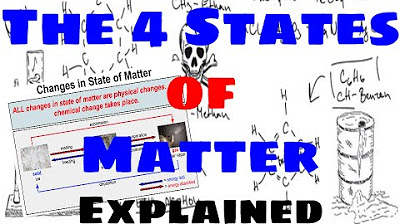CHANGES IN STATES OF MATTER || FREEZING, MELTING, CONDENSATION, EVAPORATION, SUBLIMATION, DEPOSITION
Summary
TLDRThis educational video explores the different states of matter—solid, liquid, and gas—and how matter transitions between these states. It explains freezing (liquid to solid), melting (solid to liquid), evaporation (liquid to gas), condensation (gas to liquid), sublimation (solid to gas), and deposition (gas to solid). The video also introduces plasma, a high-temperature state of matter found in the sun and lightning. Through simple explanations and everyday examples, the video helps viewers understand the scientific principles that govern these changes and their importance in the natural world.
Takeaways
- 😀 Matter exists in three main states: solid, liquid, and gas, which can change depending on temperature and pressure.
- 😀 Freezing is the process where liquid water turns into solid ice at 0°C, known as the freezing point.
- 😀 When ice absorbs heat, it melts back into liquid water at 0°C, which is called melting.
- 😀 Evaporation is the process of liquid water turning into gas (steam) when heated to its boiling point of 100°C.
- 😀 Condensation happens when water vapor cools and turns back into liquid, such as on a cold bathroom mirror after a shower.
- 😀 Sublimation is when a solid turns directly into a gas, like dry ice or snow during cold weather.
- 😀 Deposition is the reverse of sublimation, where a gas directly turns into a solid, such as frost on windows.
- 😀 The boiling point of water is 100°C, at which it changes from liquid to gas.
- 😀 Plasma is a high-energy state of matter created when gas is heated to very high temperatures, as seen in the sun and lightning.
- 😀 The freezing point of water is 0°C, the same temperature at which ice melts back into water.
- 😀 Changes in the states of matter are all part of natural processes that occur due to temperature variations and energy exchanges.
Q & A
What are the three main states of matter?
-The three main states of matter are solid, liquid, and gas.
How does temperature and pressure affect the state of matter?
-The state of matter changes depending on the temperature and pressure. For example, heating a solid can cause it to melt into a liquid, and increasing temperature can turn a liquid into a gas.
What happens when liquid water is placed in a freezer?
-When liquid water is placed in a freezer, it cools and freezes, turning into solid ice. This process is called freezing.
At what temperature does water freeze?
-Water freezes at 0°C (32°F), which is its freezing point.
What is the process of liquid turning into a solid called?
-The process of liquid turning into a solid is called freezing.
What happens when ice cubes are removed from the freezer and placed outside?
-When ice cubes are placed outside, they absorb heat from the air and begin to melt, transitioning from solid to liquid. This process is called melting.
What is the melting point of ice?
-The melting point of ice is 0°C (32°F), the same temperature at which it freezes.
What occurs during evaporation?
-Evaporation occurs when a liquid turns into a gas, such as when water boils and turns into steam. This happens when the liquid reaches its boiling point.
At what temperature does water boil?
-Water boils at 100°C (212°F), which is its boiling point.
What is condensation, and how does it happen?
-Condensation is the process in which a gas turns back into a liquid. It happens when water vapor cools down and forms liquid droplets, like when steam from a hot shower cools on a bathroom mirror.
What is sublimation, and can you give an example?
-Sublimation is the process in which a solid turns directly into a gas without becoming a liquid. An example is dry ice, which sublimates into carbon dioxide gas.
What is deposition, and how does it differ from sublimation?
-Deposition is the reverse of sublimation, where a gas turns directly into a solid without becoming a liquid. An example is frost forming on windows.
What is plasma, and how is it formed?
-Plasma is a state of matter that occurs when gas is heated to very high temperatures, causing its atoms to become ionized. The sun and lightning are examples of plasma.
Outlines

Dieser Bereich ist nur für Premium-Benutzer verfügbar. Bitte führen Sie ein Upgrade durch, um auf diesen Abschnitt zuzugreifen.
Upgrade durchführenMindmap

Dieser Bereich ist nur für Premium-Benutzer verfügbar. Bitte führen Sie ein Upgrade durch, um auf diesen Abschnitt zuzugreifen.
Upgrade durchführenKeywords

Dieser Bereich ist nur für Premium-Benutzer verfügbar. Bitte führen Sie ein Upgrade durch, um auf diesen Abschnitt zuzugreifen.
Upgrade durchführenHighlights

Dieser Bereich ist nur für Premium-Benutzer verfügbar. Bitte führen Sie ein Upgrade durch, um auf diesen Abschnitt zuzugreifen.
Upgrade durchführenTranscripts

Dieser Bereich ist nur für Premium-Benutzer verfügbar. Bitte führen Sie ein Upgrade durch, um auf diesen Abschnitt zuzugreifen.
Upgrade durchführenWeitere ähnliche Videos ansehen

3 States of Matter - Solid, Liquid, Gas

Matéria e energia [Módulo 01_Aula 01]

ESTADOS FÍSICOS DA MATÉRIA: as transformações entre líquido, sólido e gasoso

Science 5 Quarter 1 Week 5 Revised K-12 - Temperature And Its Effect On The State Of Matter

KALOR DAN PERUBAHAN WUJUD | KALOR DAN PERPINDAHAN KALOR

The Four States of Matter - Explained
5.0 / 5 (0 votes)
